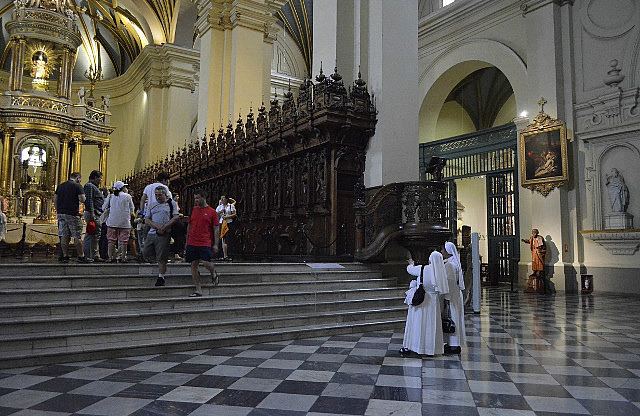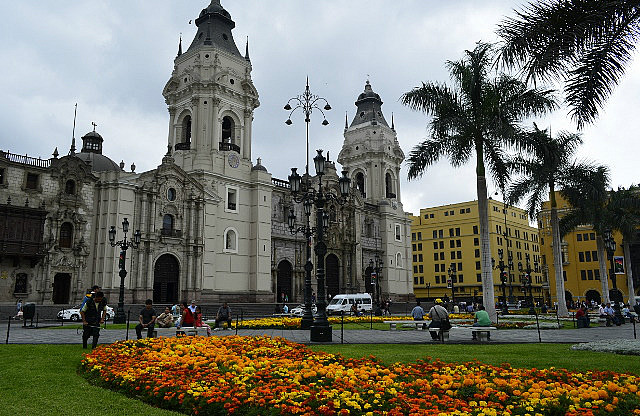The Mighty Inca Treasures
The statue "El Beso" in the center of Parque del Amor. The landscaped park overlooking the ocean with a huge kissing sculpture, mosaic walls & a snack stand. is an ideal place to walk with your partner.
January 14, 2014
Lima, Peru
“Can you take us to the Gold Museum?”we asked Paul, a Peruvian taxi driver.
“Yes, no problem,” he replied.
Our friend Joyce and I managed some Spanish, and together we bargained really hard. Paul agreed to take us to the Gold Museum for 60 nuevo soles, equivalent to US$20.00. There were five of us; so the fare was not really bad for a half hour drive.
The Museo Oro del Peru holds over 8,000 pieces of pre-Hispanic gold. They mainly originated in the north coast of Peru, and from the Moche, and Lambayeque or Sican periods.The display rooms are organized by the type of material on exhibit. We started on the ground, or main floor, where there are more than 20,000 hand combat weapons from allover the world, and from different periods. It is considered to be one of the most complete in South America. This collection is of fire arms, side arms, missile weapons, and large contusion type weapons.
“Have you seen a nut clever?” asked Bert while pointing to a knife with a hook that could cut one's testicles out in one swift move, no more fooling around! Perfect for Loreta Bobbit fans.
“Look at that sword from Afghanistan!”













I'm surprised that they have a collection from that country, I said. “What about this serrated knife? Do you think it will hurt to use it?” asked Dave. We moved from one room to another browsing through all the different kinds of weapons, sometimes we were serious, and at times laughing. Within its eight rooms, one can distinguished The Samurai Room, The Room of Historic Personages, where uniforms of different high commanders of the Armed Forces and Police can be found, as well as the various garments of Presidents of Peru and the world. Special mention is reserved for the Tizona de Pizarro, unique pieces with their class of bows, and swords encrusted in gold. It was made by the Armer Mateo in 1539 for Don Francisco Pizarro. Seeing Pizarro's bows and sword gave me the image of a tyrant riding in his horse ready to give orders to attack the Inca tribes.
Museo Oro del Peru has a large private collection of Inca gold and magnificent ceremonial objects together with militaria from South America and around the globe.
We also admired the complete sets of metal armor, and shields worn by their warriors during this period of time. We could only imagine how hard it must have been to fit into these suits of Armour. Maybe Vaseline would help?? Furthermore, we talked about how one could wear all this heavy metal; let alone be riding horses and charging at one another. Some are so fascinating with strange details, and projections, while some are almost laughable looking! There were several suits of metal body armor, that I thought looked like what Heidi Klum would wear for a Sports Illustrated pictorial. A few pieces were for the protection, and cover for the hands, and finger nails, making them look like gold and silver gloves, with matching manicures en vogue!
The museum was founded by Miguel Mujica Gallo. He started this collection at an early age. His love of hunting led him to acquire many old weapons. On seeing a pre-Columbian Tumi, (ceremonial knife), he was fascinated by it, and this led him to acquire an extensive collection of pre- Columbian treasure, as well as the many weapons on display. The Tumi cuchillo, (knife in Spanish), is the most important piece of his collection in the Gold Museum. It represents uses for both religious, and medicinal purposes. It was used by the Lambayeque, during the period of 900 -1450 AD. “The high priest used the Tumi for sacrifices. The sacrifices were carefully chosen by the high priest and the victims ages ranged from 14-16 years-old. They were usually drugged by giving them the chicha drink which served as an anesthetic, and also caused hallucinations. They also gave them the extract from cactus leaves called San Pedro,” explained the guide.
In an 18th-century viceroy's mansion, this museum offers one of the largest, best-presented displays of ceramics in Lima.
“For medicinal purposes the Tumi was also used to find out if a person had a brain tumor, or just a persistent headache. The Tumi was used to drill, pump and open up the skull, and it was later patched with gold before burying,” he continued.
``One would be shit out of luck, if he had a headache during the Ìnca period,`` joked Bert.
Anyway, the gold museum was divided into the Main Room where the main objects associated with the royal tombs, could be found. Here, we marveled at the country`s large collection of gold artifacts. There were breast plates, walking sticks, golden gloves, tunics, and a head dress in the shape of a half moon. All could rival King Tutankhamen's gold collection in Egypt. All of these belonged to the high priests, and symbolized might and power. We saw nose rings more than a foot wide and wondered if that was the right size for Dennis Rodman?? Hundreds of earrings as wide as bracelets looked very heavy and were carefully lined up in several glass cases. There was a golden mask, a rodent shaped vessel used for keeping coca leaves, and lots of clothing with gold thread.
In the Vase Room, there were a variety of vases that contained liquids, which were used for different rites. There were golden drinking vessels, pots of gold in the shape of birds, and gold rattle drinking vessels. They were mostly used by the high priest who carried out religious ceremonies, worshiping the sun. The Mummy Room displayed a variety of mummies from the central coast, as well as metal objects, and pre-Hispanic fabrics from the Vicus period . There were skulls covered with gold, while some had funerary masks. My guess is that these were the unlucky ones who had migraines! They were used by the Lambayeque rulers. In the Copper Room, there was an exhibition of copper objects used in agricultural activities.
The Inca market that boasts handcrafted objects and typical Peruvian souvenirs -traditional textiles, Inca style jewelry, Peru's famous alpaca scarves, and shawls.
Our whole morning was spent on the interesting tour at the Museu Oro del Peru. Our next stop was at the Inca Market in Miraflores. It is located at the neighborhood which was full of prosperous, young residents. It probably has some of the best homes. It is, without doubt, one of the most popular places for tourists, foreign expatriates, and locals (who can afford it). The coastal district has a lot to offer in form of cafe's, restaurants,bars and clubs. The Inca Market is where artisans sell nearly everything that Peruvian craftsmanship has to offer. There were the typical souvenirs, awesome artisan craft work, beautiful jewelry, clothes made of Peru`s famous Alpaca, t-shirts, pottery,paintings, wooden carvings, and leather work from all over Peru. Our shopping for the day, done, we headed back to the Marriott Hotel where we waited for our frees shuttle bus back to the port.
The view on the way to Miraflores.
Many thanks to the friendly and very helpful staff of the Marriott Hotel. The free Wi-Fi was also a nice treat!!! One thing we like about Holland America Line is that we get pampered at every port stop. The free shuttle bus service was really a welcome treat; especially after a long day of touring and shopping. We were back on the ship shortly after 6:00 pm where we enjoyed a very typical South American barbecue! Ole!
Comments
Wooohooo......now I have been to Lima too!! Thanks for taking me along with you guys!! Stay well and enjoy your next leg of this incredible journey!! From Marcelle, on Jan 21, 2014 at 06:19 AM Thanks for sharing guys...Its seems like I am there with you. F From Freedom, on Jan 22, 2014 at 02:07 AM
